How to Book Online Train Tickets in China
China has excellent high-speed and night train services linking cities across the country, and every ticket can be easily booked through Trip.com:
Trip.com is by far the most customer-friendly website to book your Chinese train tickets, as it has an extremely easy-to-use interface and accepts all foreign debit and credit cards.
Whether you want to book a Chinese high-speed train between Beijing and Shanghai, take the night train to Xi’an or Hong Kong, or explore stunning regions such as Yunnan, Trip.com can handle all your train ticket bookings in China.
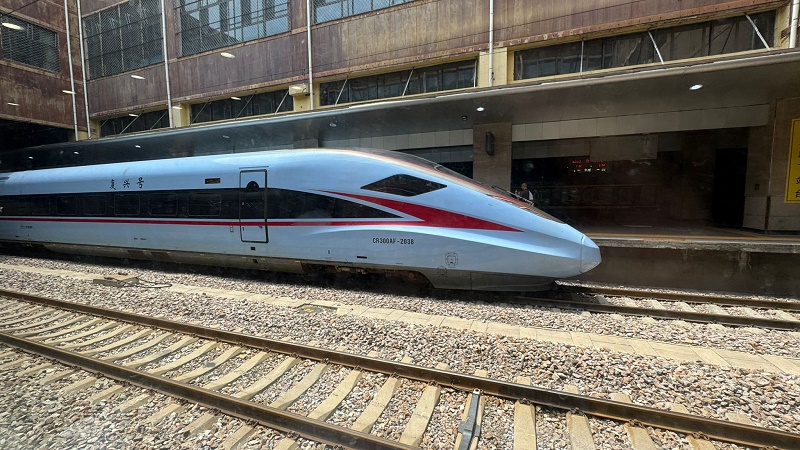
Advantages of using Trip.com to book Chinese train tickets
The official website for China’s railways is 12306.cn, which is primarily app-based. Although it generally works well, it can be somewhat cumbersome to use, as it is not always easy to navigate and often has issues accepting some foreign debit or credit cards.
Personally, I prefer to use Trip.com because it is so much easier to navigate and find the best train connections for your travels through China.
You simply choose the train you want and make the payment without any issues, as all major international debit and credit cards are accepted. Once the booking is complete, you will instantly receive confirmation, including your train number, carriage number, and seat number – and then you’re ready to go. It’s a very straightforward and convenient process.
A great feature of Trip.com is that it can also reserve your tickets in advance. Chinese train bookings only open 15 days before departure, but with Trip.com, you can make a reservation earlier. Once the booking window opens for your chosen train, Trip.com will automatically secure the ticket for you. It’s a convenient service that saves you the trouble of setting an alarm to book your tickets on time!
Your passport as ticket
All Chinese train tickets are linked to your passport number – so be sure to enter your details correctly when booking your trains.
When you book your ticket, you will receive a confirmation showing your train, seat, and carriage number. You will not receive an e-ticket or a paper ticket, as China does not use them – instead, you simply use your passport to pass through the station ticket gates and board your train.
Chinese high-speed trains
China’s vast high-speed rail network connects all major cities throughout the country. There are different categories of Chinese high-speed trains:
- G category trains (gāotiě, 高铁) are the top-tier high-speed services, reaching speeds of up to 350 kilometres per hour (217 mph) and offering the highest level of comfort on board. Consequently, they are also the most expensive trains in China and can be costly even by Western standards.
- D category trains (dòngchē, 动车) are slightly slower and less premium high-speed trains, with lower price levels.
- C category trains (chéngjì, 城际) are short-distance high-speed services that link nearby cities, such as the short ride between Beijing and Tianjin.

Travel classes on Chinese high-speed trains
Chinese high-speed trains have several travel classes, each differing in comfort and price.
- Second class is the most common and economical option, featuring compact seats in a 2+3 layout across the carriage.
- First class provides wider, more comfortable seats arranged 2+2, giving passengers extra space and a quieter atmosphere.
- Superior class, available on some G-category services, is pitched between first and business class in terms of quality. These seats are usually located directly behind the driver’s cab. This class is sometimes labelled Premium, Premier, or Deluxe.
- Business class, available on G-category services, represents the most luxurious option on Chinese high-speed trains, consisting of spacious, leather reclining seats configured in a 2+1 or 1+1 layout across the coach. These seats convert into lie-flat beds if you want to take a rest.
In first and superior class, passengers usually receive a drink and a small selection of snacks. Business class offers a more substantial service, often including a full meal served on a tray at your seat. Most high-speed trains also have a small buffet car, where passengers can purchase drinks, snacks, or meals.
Trip.com can book tickets in all of the aforementioned travel classes on Chinese high-speed trains.
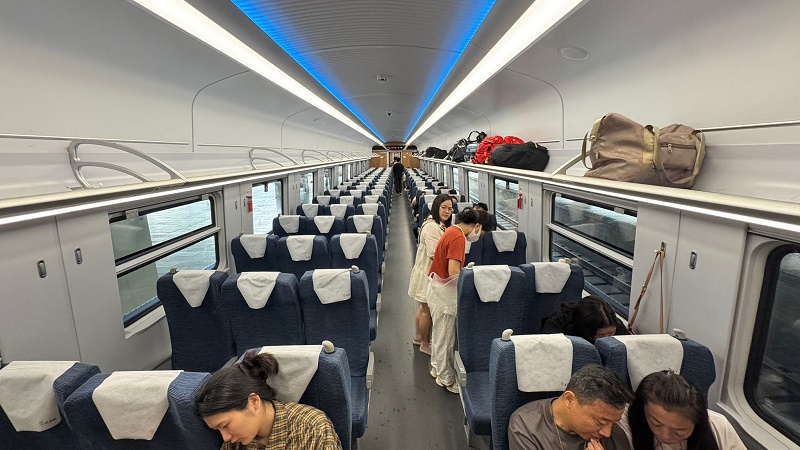
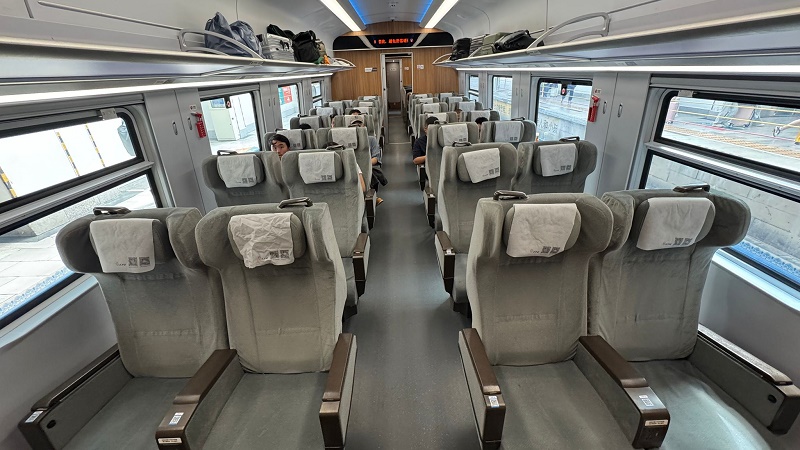
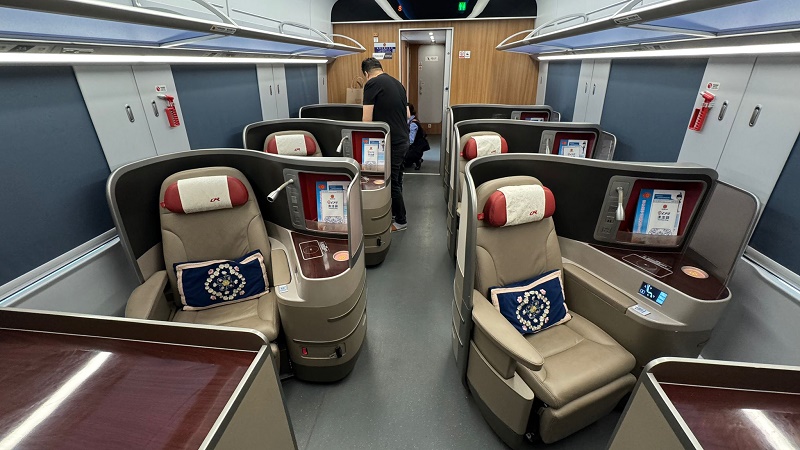
Other trains in China
Conventional trains in China – including night services – are categorised by speed and quality level.
- Z category trains (zhídá, 直达) provide fast, direct overnight connections between major cities, offering soft sleepers and deluxe sleepers.
- T category trains (tèkuài, 特快) travel slightly slower over long distances, stopping at more intermediate stations, with both soft and hard seating and soft and hard sleeper options available.
- K trains (kuàisù, 快速) are the oldest and slowest trains, making frequent stops, and providing a range of hard and soft seats, as well as sleepers.

Travel classes on conventional trains in China
Conventional trains in China have several travel classes, each differing in comfort and price.
- Hard seat: Similar to second class on European trains
- Soft seat: Similar to first class on European trains
- Hard sleeper: Open-plan compartments with six berths per bay (upper, middle, and lower)
- Soft sleeper: 4-berth compartments with two upper and two lower berths
- Deluxe sleeper: 2-berth compartment with a sink, en-suite bathroom with toilet (and sometimes shower)
Note that the term “hard” in “hard seat” or “hard sleeper” does not mean the seat or berth is literally hard or uncomfortable. The distinction between “hard” and “soft” simply refers to the difference in comfort and quality, with soft seats and sleepers being slightly wider, having better padding, and fewer passengers per carriage.
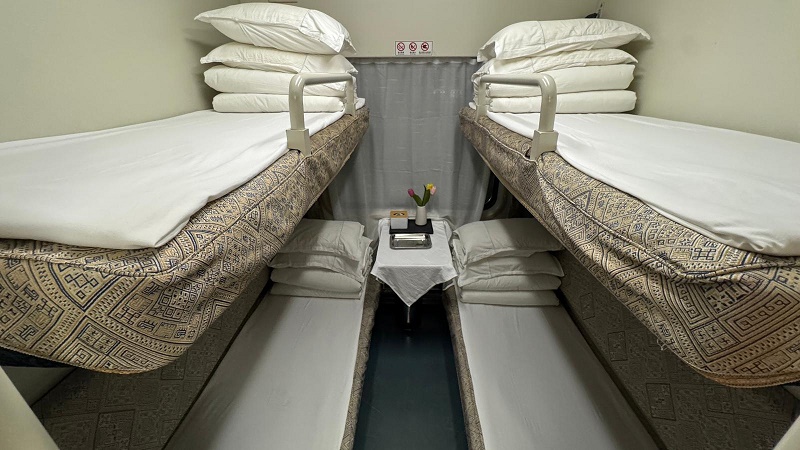
Travel abroad? Don’t forget to buy an eSIM
For many international travellers, staying connected while abroad is essential, and an Airolo eSIM is one of the best ways to get mobile data to get access to the internet, send text messages, and make or receive calls. Courtesy of DiscoverByRail you can now get a 15% discount on your Airolo eSIM!
